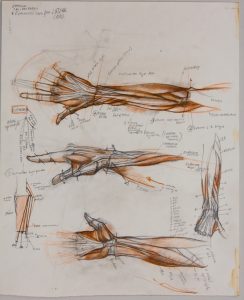My speech at the ICAA
WELCOME to this book launch and celebration of classical art!!
I am so happy to see you here, and to welcome you to this wonderful evening of discussion about the value and importance of modern classicism. It’s a quixotic but urgent topic. I am here on stage with four of my favorite people—the honorable vice consul Signore Stefano Acunto, Jim Cooper, Peter Trippi, my husband Sabin Howard–to discuss this topic with you, and I’m so excited.
Please note there’s a lovely woman with an iPhone that can take your credit card information, if you’d like to buy a book. Sarah, where are you?
Let me take this opportunity to thank a few people, the ICAA and Signore Acunto and Mrs. Carole Acunto, Jim Cooper, Peter Trippi, David Ludwig, Todd Deskins, Sarah Miniaci, Drew Stevens, Don Steelman.
So, about this book THE ART OF LIFE….
A few weeks ago, in speaking with the honorable vice consul Steve Acunto, I told him that I would begin my talk by saying, “The Republicans think art is for sissies, and Democrats think art has to be ugly to be real art.”
“Well, Traci,” responded Signore Acunto, “then you shall have to wear a breastplate and helmet.” So rather than turn myself into a valkyrie, I decided to think more deeply about what I meant, polemics aside.
At this point I should probably disclose that, politically, I am currently a radical skeptic, and there are two groups whom I view with skepticism: Democrats and Republicans. Also, liberals and conservatives. Here in the waning years of the American Empire, partisan politics has made fools of us all.
And yes, art is political. I believe my husband Sabin will tell you that art is not political—that it transcends petty ephemeral concerns. But I believe that art speaks to who we are and how we want to live, so it’s very political.
So is ugly art real art because that gives certain groups the virtuous feeling that they support freedom?
When I ask the question that way, you already know where I stand.
It’s amazing to think that the 20th century which gave rise to repeated genocides–repeated genocides–also gave rise to new intent and new methods to better ourselves, to become, as a human race, better–peaceful and tolerant. I am thinking about Gandhi, Mother Theresa, and Dr. Martin Luther King.
Along the way to evolving and becoming better as a human race, something happened. The problem for me is that in throwing out the bathwater, we threw out the baby. In throwing out discrimination, we threw out discernment. And we need discernment.
We need to discern between what is masterful and what is silly, what is skilled and what is sloppy, what is art and what is not. Currently in the culture there’s a underlying attitude among some groups that it’s not acceptable to discern, that to say, ”Sabin Howard’s work is art and Dung Madonna is not” makes you a (fill in the blank with the latest catchphrase for bad person) Nazi rascist bigot. Sabin calls this the “I’m ok, you’re ok, even the serial killer down the road” mentality.
But we do discern. Human beings intuitively sense mastery. We have an innate ability to look at something and see that it is beautiful, that it is powerful, that thought and skill and vision went into it. We just know.
But in much of the contemporary art world we are not supposed to know. We are not supposed to look. We’re supposed to understand visual art through our ears. We are supposed to listen to the heady babble of professors, PhD’s, and my personal favorite, gallery owners who have something to sell. We’re supposed to read the manual–The New York Times. We are supposed to stifle our authentic human response to a work of art.
So when an institution such as the National Endowment for Self-Expression funds images of the Virgin Mary submerged in urine, that institution may be pretending to support freedom, but what it is actually doing is legitimizing the stifling of our authentic human response to a work of art.
Don’t buy it. They’re selling snake oil. It’s scam art.
Marcel DuChamp did us all a disservice when he foisted a urinal on us. It would have been fine for a few minutes of intellectual shock value and entertainment. But here it is, 100 years later, and art is still being flushed down the toilet.
I am here to tell you: the emperor has no clothes.
The manual is irrelevant: looking is the point. Beauty is the point. Mastery is the point.
This doesn’t mean that there isn’t a place for ornamentation, decoration, entertainment, embellishment, and illustration. This doesn’t mean there isn’t a place for freaky fun. It means you can see the difference.
Now what about the other part of my polemical statement, art is for sissies.
I think this goes back to certain prevailing cultural notions about what’s butch and what’s manly, besides creating estate tax loopholes. Because you know, creating tax loopholes is very butch. It goes to our fascination with the anti-hero, with irony. We’re Americans, we’re outlaws, we’re renegades, we’re riding into the sunset. But we’d better watch out, because China is riding back out of the sunrise toward us. They’re bringing it.
And we’re responding with irony. TV and movies, the popular culture, is full of anti-heroic irony. It’s a defense. It’s a weak defense. Ultimately, it’s a defense against an open heart.
What art does, real art, REAL ART, is gives you an experience of an open heart. Whether it’s a novel, or a movie, or a well acted King Lear, or a painting or a piece of sculpture, you have an experience or your heart opening. You’re a better person because of it.
Real art uplifts you—it transforms you. It gives you an experience of transcendence, whether of joy or of sorrow, because both joy and sorrow move through an open heart.
Sabin Howard’s pieces lack irony as a deliberate choice to give the viewer an experience of the heart opening, of upliftment, of transformation. This is the most courageous choice of all. This is the most radical choice of all. This is the most visionary choice of all.
The great poet Rumi says:
In your light I learn how to love.
In your beauty, how to make poems.
You dance inside my chest where no-one sees you,
but sometimes I do,
and that sight becomes this art.
Thank you.





